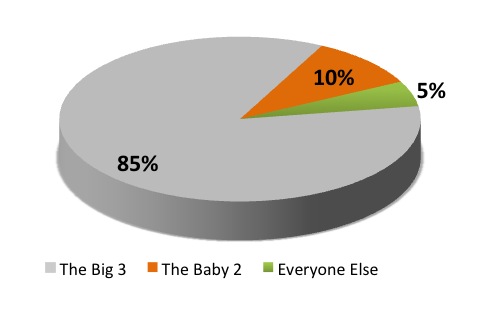In October we highlighted a clear and present danger resulting from the further consolidation of the Core IT vendors. Fewer vendors exist than ever before and the impact to your service level, legal rights and business options are even slimmer if the institution does not make restructuring your relationship and contract a strategic board-level matter. We teamed up with attorney Gary Findley to put on a national web seminar on this very topic that was widely attended by CEOs and CFOs of all sized institutions. With tremendous feedback we have scheduled an encore presentation on December 10th and 11th if you are interested in joining and hearing some proprietary legal and business strategies on how to manage and mitigate this major risks area please attend.
Oligarchy in Formation
In excess of 85% of the market is controlled today by services provided by the BIG THREE known as Fiserv, Fidelity and Jack Henry & Associates. The BABY TWO including CSI and D+H Harland control approximately 10% more and every other off-brand regional provider address just less than 5%. These 5 providers I refer to as the CORG (BORG with a 'C' for "Core" if you are a Star Trek fan). The CORG provide all the critical services a bank or credit union may ever need in the back office or for their customer relationship including: Account Processing, Item Processing, Internet Banking, Bill Payment, ATM/EFT, Loan Processing, Card Services, WAN Telecom, etc.

Tying up so many services in multi-year, multi-million dollar contracts in the absence of new, outside competition is nothing less than an oligarchy in formation that the industry, and your institution, must seriously reconsider. Having been a former IT vendor for many, many years I understand just how important these services are to your franchise and I also appreciate and respect just how hard these firms work to provide a valuable service but it doesn't change the fact that free-market forces no longer have a foot on the neck of any of these providers. Paladin research and independent industry reports from the BPI Network and others clearly shows that the pendulum is swinging more toward the CORG than your ORG.
Legal Strategy

Gary Findley has untold number of years advising community banks on these matters and as a corporate attorney and merger specialist he sees the impact first-hand of how institutions are caught flat-footed when its time to tussle with the CORG.
Shareholders are hurt badly when an institution attempts a merger and these contracts are pulled from the shelf and the dust blown from their voluminous, endless-addendum and legalese. His advice is simple:
- Do your homework - make sure vendor service fits long term.
- Get legal opinion on areas of concern (there are many).
- Open a negotiation immediately (even if mid-term).
- Get outside advice on market intel, business terms and pricing.
- View vendor change as an OPPORTUNITY to get what you want.
- Don't sit idle and wait for the CORG to come to you. You'll lose.
Mr. Findley will be the other panelist expert at the webinar scheduled for December 10th and 11th featured above.
Market Drivers and Lack of Price Efficiency
Real World Pain of Vendor Assimilation
Facts are that 8 out of 10 institutions are paying above market pricing and also have very unfavorable terms in their current CORG agreement - it's really a matter of degree. There are many obvious indicators we look for when providing our research to a community bank or credit union during a cost assessment and/or fairness opinion on the status of their contract, business terms, service level and pricing. If we learn that the institution was originally working with a vendor that had been purchased by a competitor (and sometimes purchased again) we know the likelihood of that institution paying significantly above Fair Market Value (see Paladin Blue Book) is almost assured. Learning that an institution has gone through one, two or more renewals (more than 10 years of services) without objectively restructuring the deal with outside help - that's a gimme as well. We recently dealt with a bank that was a former Fiserv client; moved to OSI about 5 years ago because they were unhappy and now they are right back on Fiserv's doorstep through the acquisition of OSI in 2012. Should they be paying Fiserv prices or can they rely on the contract language in the OSI agreement. If so, for how long? When can they expect Fiserv to drop the hammer on them - or not? Our advice is it is better to move now than wait, but few bankers find the time or courage to tackle something as foreign as a core IT contract when their career training is in banking and credit..not IT.
Advantage: CORG.






